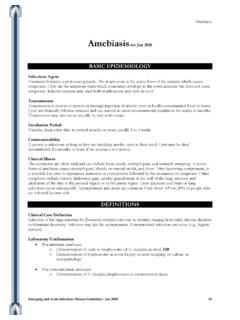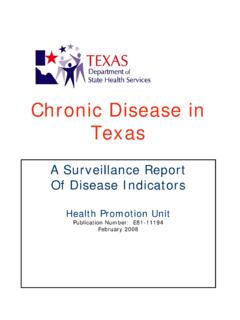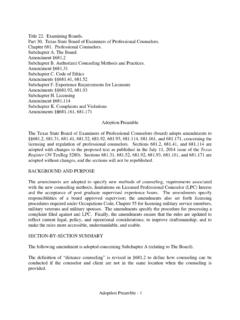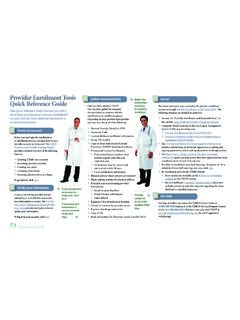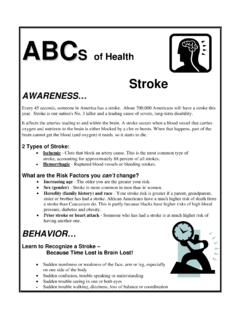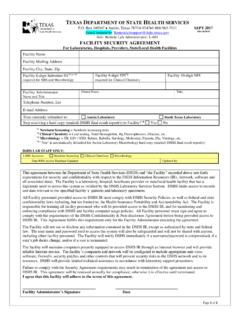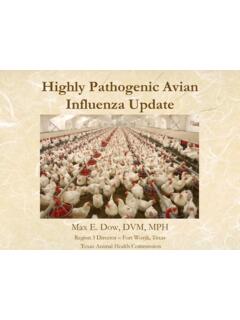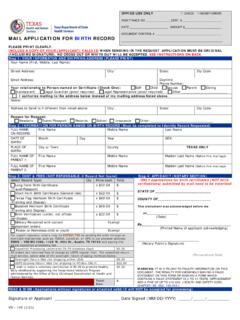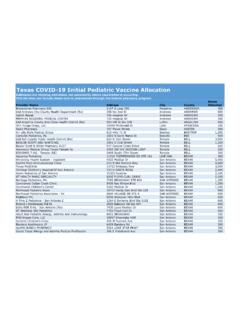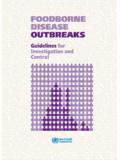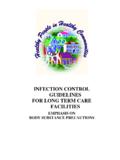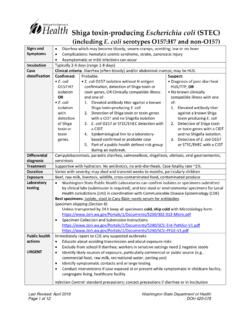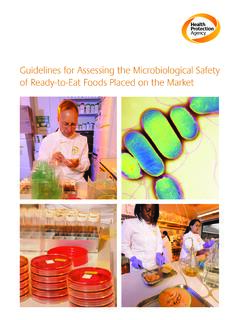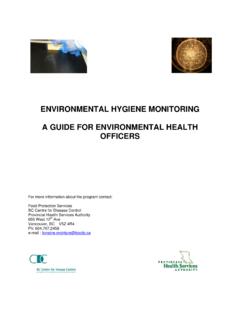Transcription of Typhoid Fever (Salmonella Typhi)
1 Typhoid Fever Typhoid Fever (Salmonella Typhi) rev March 2021. BASIC EPIDEMIOLOGY. Infectious Agent Salmonella enterica serovar Typhi (S. Typhi) is the etiologic agent of Typhoid Fever . Transmission Transmission primarily occurs through ingestion of food or water contaminated with the stool and sometimes urine of a Typhoid Fever case or an asymptomatic carrier of the organism. It has been documented that Typhoid Fever has been transmitted sexually from an asymptomatic carrier. Most cases of Typhoid Fever are travel-related and involve an exposure that occurred in an endemic region ( , primarily Asia, Africa, and Latin America). Humans are the only known reservoir of S. Typhi. Incubation Period Typically, ranges from 8 to 14 days. However, incubation can range from 3 to 60 days. Communicability Humans are infectious as long as bacteria are shed in their stool and/or urine. Shedding in stool occurs throughout the course of infection, usually lasting several days to several weeks, with 2-5% of cases becoming chronic carriers capable of excreting the organism for many months.
2 Urinary shedding is less common than fecal shedding. Antibiotic use during the acute illness can prolong the carrier state. Both treated and untreated patients may become chronic carriers of the organism. The most common population for chronic carriers are middle-aged women with a history of biliary duct abnormalities, such as gallstones. Clinical Illness Symptoms typically include sustained Fever (may reach 103-104 F), headache, and malaise. Most adults experience constipation, rather than diarrhea. Additional symptoms include anorexia, bradycardia, splenomegaly, non-productive cough, rose spots on the trunk, mental dullness, slight deafness, parotitis, or the development of Peyer patches in the ileum, which may ulcerate and result in intestinal hemorrhage or perforation in 3% of cases. Despite antimicrobial treatment, relapses causing milder illness can occur in 15-20% of cases. Severity The severity of Typhoid Fever is dependent on multiple factors; , age, prior exposure (via illness or vaccination), number of organisms ingested, virulence of the strain ingested, duration of illness (including time until treatment is initiated).
3 Cases with mental or neurological symptoms have been associated with higher mortality rates. Mortality rates range from 10%-20% without treatment to 1%. with access to antimicrobials. Emerging and Acute Infectious disease guidelines -May 2021 385. Typhoid Fever DEFINITIONS. Clinical Case Definition An illness caused by Salmonella Typhi that is often characterized by insidious onset of sustained Fever , headache, malaise, anorexia, relative bradycardia, constipation or diarrhea, and nonproductive cough. However, many mild and atypical infections occur. Carriage of S. Typhi can be prolonged. Laboratory Confirmation Isolation of S. Typhi from blood, stool, or other clinical specimen. Case Classifications Confirmed: A clinically compatible case that is laboratory confirmed. Probable: A clinically compatible case with S. Typhi detected by use of culture independent laboratory methods (non-culture based), OR. A clinically compatible case that is epidemiologically linked to a case that meets the probable or confirmed laboratory criteria for diagnosis Note: a case should not be counted as a new case if laboratory results were reported within 365 days of a previously reported infection in the same individual, unless additional information is available indicating a separate infection SURVEILLANCE AND CASE INVESTIGATION.
4 Case Investigation Local and regional health departments should promptly investigate all reports of Salmonella Typhi. Investigations should include an interview of the case or a surrogate to get a detailed exposure history. Please use the CDC Typhoid and Paratyphoid Fever Surveillance Report available on the DSHS. website: Case Investigation Checklist Confirm laboratory results meet the case definition. Contact laboratory to determine if an isolate has been sent to the DSHS laboratory. If an isolate has not been sent, please request a specimen be submitted. o Note: The submission of S. Typhi isolates is not required by state law, but it is critical for the detection and investigation of outbreaks. Review medical records or speak to an infection preventionist or healthcare provider to verify case definition, identify possible risk factors and describe course of illness. o Use information from medical records to complete the CDC Typhoid and Paratyphoid Fever Surveillance Report.
5 Interview the case to get travel history and other risk factor information. o Make special note of the case's travel history. If the case-patient does not report travel outside of the , ask again about travel. If the answer is still negative, inquire about any visitors from a country where Typhoid Fever is endemic, especially any who might have stayed in the case-patient's household, prepared food, cared for, or had close contact with the case-patient. Ask about prior cases of Typhoid Fever among members of the household, extended family, or friends. Ask about consumption of raw or undercooked shellfish or bivalves (oysters, scallops etc.) If no history of travel to an endemic country, exposure to an imported case or history Emerging and Acute Infectious disease guidelines -May 2021 386. Typhoid Fever of consumption of raw or undercooked seafood is identified, call an EAIDU. epidemiologist immediately to discuss the case. o Make special note if the case is a food worker.
6 Food workers who are diagnosed with Typhoid Fever are subject to work exclusion requirements. See Exclusions. o Use the CDC Typhoid and Paratyphoid Fever Surveillance Report to record information from the interview. o If the case is not available or is a child, conduct the interview with a surrogate who would have the most reliable information on the case, such as a parent or guardian. o Provide education to the case or his/her surrogate about effective hand washing and food safety practices. See Prevention and Control Measures. Fax completed forms to DSHS EAIDU at 512-776-7616 or email securely to an EAIDU. epidemiologist at o An EAIDU foodborne epidemiologist will fax the form (de-identified) to the CDC. o Please note that the CDC measures the proportion of interviews reported to CDC. within 7 days of interview date, so please send the form as soon as possible. o For lost to follow-up (LTF) cases, please complete as much information as possible obtained from medical/laboratory records ( , demographics, symptomology, onset date, etc.)
7 On the investigation form and fax/email securely to DSHS EAIDU. noting case is LTF. Hospitalized cases should be followed until discharge and patient's outcome recorded on the Typhoid and Paratyphoid Fever Surveillance Report. o Initial reports can be sent to DSHS prior to discharge. In the event of a death, copies of the hospital discharge or death summary should also be faxed to DSHS EAIDU or emailed to If the case is part of an outbreak or cluster, see Managing Special Situations section. All confirmed case investigations must be entered and submitted for notification in the NEDSS Base System (NBS). Please refer to the NBS Data Entry guidelines for disease specific entry rules. Prevention and Control Measures For those traveling to an endemic region: o Receive the Typhoid Fever immunization (1 to 2 weeks prior to travel, time frame varies based on type of vaccine). o Only eat fresh raw fruit and vegetables that can be peeled, peel them yourself, don't eat the peels, and wash your hands before and after handling.
8 O Avoid food and drinks sold from street vendors. o Avoid ice, frozen drinks, or other items made from an unknown water source. o Drink bottled water (or boil non-bottled water for >1min) and avoid swallowing tap water while showering and brushing teeth. o Carbonated water is safer to drink than non-carbonated water. Practice routine hand washing with soap and warm water, especially: o Before preparing or after handling or eating any food. o After going to the bathroom. o After changing a diaper. o After caring for someone with diarrhea. o After handling raw food. Avoid consuming raw or undercooked shellfish and bivalves (oysters, scallops, mussels etc.), especially in endemic countries. Avoid consuming raw milk, unpasteurized dairy products, and undercooked eggs. Emerging and Acute Infectious disease guidelines -May 2021 387. Typhoid Fever Exclusions School/child-care: Children with Salmonella Typhi should be excluded from school/child-care until they are free from Fever and diarrhea for 24 hours without the use of Fever or diarrhea suppressing medications.
9 Children must have three consecutive negative stools before being allowed to return to school. The stool specimens should be collected at least 24 hours apart and not sooner than 48 hours after the last dose of antibiotics, if antibiotics were given. Food Employees: Symptomatic food employees infected with Salmonella Typhi are to be excluded from work. Food employees can be reinstated with approval from the Regulatory Authority and if the following condition is met: Medical documentation by a health practioner stating that the food employee is free of infection from Salmonella Typhi. Please see Guide to Excluding and Restricting Food Employees in Appendix A. Emerging and Acute Infectious disease guidelines -May 2021 388. Typhoid Fever MANAGING SPECIAL SITUATIONS. Outbreaks If a Salmonella Typhi outbreak is suspected, immediately notify the appropriate regional DSHS office or DSHS EAIDU at (512) 776-7676. The local/regional health department should: Interview all cases suspected as being part of the outbreak or cluster.
10 Request medical records for any case in your jurisdiction that died, was too ill to be interviewed, or for whom there are no appropriate surrogates to interview. Prepare a line list of cases in your jurisdiction. Minimal information needed for the line list might include patient name or other identifier, DSHS or laboratory specimen identification number, specimen source, date of specimen collection, date of birth, county of residence, date of onset (if known), symptoms, underlying conditions, treatments and outcome of case, and risky foods eaten, foods eaten leading up to illness, or other risky exposures, such as animal contact and travel, reported by the case or surrogate. Line list example: ID Name Age Sex Ethnicity Onset Symptoms Food Animal Notes 1 NT 34 F W/N 2/4/16 Bl. D, F Chicken, Dog Dog food eggs 2 PR 2 M U/U 1/30/16 V,D,F Chicken, None Brother ill spinach If the outbreak was reported in association with an apparent common local event ( , party, conference, rodeo), a restaurant/caterer/home, or other possible local exposure ( , pet store, camp), contact hospitals in your jurisdiction to alert them to the possibility of additional Salmonella Typhi cases.
